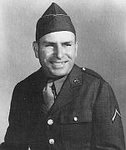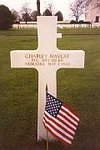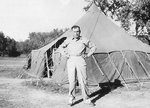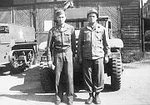syscom3
Pacific Historian
Charles Havlat: The last GI killed in action, a Czech-American, died in Bohemia after the European cease-fire
[09-05-2005] By Brian Kenety
Charles Havlat is thought to be the very last American soldier killed in action in the European operations of World War II. The son of Czech immigrants, he took a bullet in the head while on patrol in southern Bohemia; shot by German soldiers who were unaware that a ceasefire had been declared and whose commander later apologised. Brian Kenety reports.
Pfc Charles Havlat of the 803rd Tank Destroyer Battalion"Charley and Rudy were in the 803rd, tank division, yeah. During the war years, I was in the First Division of the First [US] Army. Charley was the oldest; I'm the youngest..."
Adolph Havlat, now in his early eighties, was one of three Czech-American brothers from the close-knit farming community of Dorchester, Nebraska, to serve in Europe during the Second World War. Rudolph Havlat passed away a couple of years ago. Their oldest brother Pfc Charles Havlat, was the last American GI killed in action on the 5th Division front, and is officially the last American KIA in the entire European Theatre. He was 34 years old.
"What happened to Charley? Well, he was on reconnaissance with another outfit, the 737th tank battalion, with the re-con outfit. And they were in a jeep in a 'bowl' area..."
Pfc Charles Havlat in basic trainingMay 7, 1945, 08:40: On a dirt road some 12 kilometres into Czechoslovakia, a reconnaissance platoon of the US Army's 803rd Tank Destroyer Battalion, Company C, is blindsided by a hail of enemy machine gun and small arms fire from concealed positions in the woods. Soldiers from the German 11th Panzer Division fire off four rounds of panzerfausts, which explode around the lead American vehicle, an M-8 armoured car. The American GIs in the second vehicle, an open jeep, get the worst of it: Two take hits to the hands and face: Pfc Charley Havlat is killed.
"Charley... Well, he fired once at the enemy and then I guess he ducked down at the hood of the jeep. But he forgot to move in another direction and he peeked back up, I guess, at the same position and they apparently had a bead right on him, so... and he died instantly. That's what I've been told, anyway."
The re-con men of the 803rd returned fire until their radio operator received word that, some nine minutes before the ambush, a cease-fire order had gone into effect, and an armistice was in effect. The company got orders to withdraw back into the town of Wallern, now known as Volary. Less than six hours after the attack, Nazi Germany surrendered unconditionally. Taken captive later, the German officer who led the ambush said he knew nothing of the cessation of hostilities until 30 minutes after their effective time and apologised for the incident.
Havlat's brothers Adolph and Rudolph, in Wallern (Volary)The Havlat brothers were unaware of just how unlucky Charley had been until half a century later.
"We actually didn't hear about this until about 1995 - that he was the last killed, until it was published in the VFW [Veterans of Foreign Wars] magazine... Other people knew it - Harry Haines and some of the others in the outfit probably knew it, but we didn't know it..."
Charles Havlat's grave in FranceHarry Haines was a member of the 737th tank battalion, for which Charley's unit was doing reconnaissance work in those final days of World War II. Decades later, Mr Haines, a native of Houston, Texas, would help Adolph Havlat lobby the state of Nebraska to pay tribute to Charley.
2nd lieutenant Harry Haines had been driving in a jeep north of Wallern (Volary) with a medic in search of Schnapps for the platoon, to celebrate the end of the war. On the way back, he saw an American lieutenant stranding on top of an armoured car, waving a tree branch with a white cloth tied to it. "What the hell is going on here?" Haines asked. The officer replied, "the Krauts don't know the war is over."
In May 1945, Adolph Havlat was serving at SHAPE, Supreme Headquarters Allied Powers Europe, in the prisoner-of-war and displaced persons division. He was in Frankfurt, Germany when informed of Charley's death. That was in June, weeks after the war in Europe ended.
"I hitch-hiked over to Wallern (Volary), where Rudy was stationed, and then together we went to see his temporary gravesite..."
Highway 33 out of Dorchester, NebraskaPfc Charles Havlat now has a permanent grave at the Saint Avold World War II veteran's Cemetery near Metz, France. And a military club in the Czech city of Plzen paid for a memorial plaque to be placed at the spot where he was killed. But Adolph Havlat's efforts to have his older brother Charley's memory honoured in his home state of Nebraska haven't been successful.
"I can't get anything going here. I was going to set up something in Dorchester, where he was from at the time, and I was going to name part of Highway 33 after Charley... There are quite a few Czechs around Dorchester and Crete, which is eight miles to the east, and that part of the highway in between is Highway 33, which he used to travel quite a bit as a trucker in pre-war days."
Mr Havlat says that officials from Dorchester and Crete gave their okay for the proposal, but Highway 33 is a state highway, and he hasn't managed to get an okay from Nebraska officials to rename it: The Charles Havlat Memorial Highway.
[09-05-2005] By Brian Kenety
Charles Havlat is thought to be the very last American soldier killed in action in the European operations of World War II. The son of Czech immigrants, he took a bullet in the head while on patrol in southern Bohemia; shot by German soldiers who were unaware that a ceasefire had been declared and whose commander later apologised. Brian Kenety reports.
Pfc Charles Havlat of the 803rd Tank Destroyer Battalion"Charley and Rudy were in the 803rd, tank division, yeah. During the war years, I was in the First Division of the First [US] Army. Charley was the oldest; I'm the youngest..."
Adolph Havlat, now in his early eighties, was one of three Czech-American brothers from the close-knit farming community of Dorchester, Nebraska, to serve in Europe during the Second World War. Rudolph Havlat passed away a couple of years ago. Their oldest brother Pfc Charles Havlat, was the last American GI killed in action on the 5th Division front, and is officially the last American KIA in the entire European Theatre. He was 34 years old.
"What happened to Charley? Well, he was on reconnaissance with another outfit, the 737th tank battalion, with the re-con outfit. And they were in a jeep in a 'bowl' area..."
Pfc Charles Havlat in basic trainingMay 7, 1945, 08:40: On a dirt road some 12 kilometres into Czechoslovakia, a reconnaissance platoon of the US Army's 803rd Tank Destroyer Battalion, Company C, is blindsided by a hail of enemy machine gun and small arms fire from concealed positions in the woods. Soldiers from the German 11th Panzer Division fire off four rounds of panzerfausts, which explode around the lead American vehicle, an M-8 armoured car. The American GIs in the second vehicle, an open jeep, get the worst of it: Two take hits to the hands and face: Pfc Charley Havlat is killed.
"Charley... Well, he fired once at the enemy and then I guess he ducked down at the hood of the jeep. But he forgot to move in another direction and he peeked back up, I guess, at the same position and they apparently had a bead right on him, so... and he died instantly. That's what I've been told, anyway."
The re-con men of the 803rd returned fire until their radio operator received word that, some nine minutes before the ambush, a cease-fire order had gone into effect, and an armistice was in effect. The company got orders to withdraw back into the town of Wallern, now known as Volary. Less than six hours after the attack, Nazi Germany surrendered unconditionally. Taken captive later, the German officer who led the ambush said he knew nothing of the cessation of hostilities until 30 minutes after their effective time and apologised for the incident.
Havlat's brothers Adolph and Rudolph, in Wallern (Volary)The Havlat brothers were unaware of just how unlucky Charley had been until half a century later.
"We actually didn't hear about this until about 1995 - that he was the last killed, until it was published in the VFW [Veterans of Foreign Wars] magazine... Other people knew it - Harry Haines and some of the others in the outfit probably knew it, but we didn't know it..."
Charles Havlat's grave in FranceHarry Haines was a member of the 737th tank battalion, for which Charley's unit was doing reconnaissance work in those final days of World War II. Decades later, Mr Haines, a native of Houston, Texas, would help Adolph Havlat lobby the state of Nebraska to pay tribute to Charley.
2nd lieutenant Harry Haines had been driving in a jeep north of Wallern (Volary) with a medic in search of Schnapps for the platoon, to celebrate the end of the war. On the way back, he saw an American lieutenant stranding on top of an armoured car, waving a tree branch with a white cloth tied to it. "What the hell is going on here?" Haines asked. The officer replied, "the Krauts don't know the war is over."
In May 1945, Adolph Havlat was serving at SHAPE, Supreme Headquarters Allied Powers Europe, in the prisoner-of-war and displaced persons division. He was in Frankfurt, Germany when informed of Charley's death. That was in June, weeks after the war in Europe ended.
"I hitch-hiked over to Wallern (Volary), where Rudy was stationed, and then together we went to see his temporary gravesite..."
Highway 33 out of Dorchester, NebraskaPfc Charles Havlat now has a permanent grave at the Saint Avold World War II veteran's Cemetery near Metz, France. And a military club in the Czech city of Plzen paid for a memorial plaque to be placed at the spot where he was killed. But Adolph Havlat's efforts to have his older brother Charley's memory honoured in his home state of Nebraska haven't been successful.
"I can't get anything going here. I was going to set up something in Dorchester, where he was from at the time, and I was going to name part of Highway 33 after Charley... There are quite a few Czechs around Dorchester and Crete, which is eight miles to the east, and that part of the highway in between is Highway 33, which he used to travel quite a bit as a trucker in pre-war days."
Mr Havlat says that officials from Dorchester and Crete gave their okay for the proposal, but Highway 33 is a state highway, and he hasn't managed to get an okay from Nebraska officials to rename it: The Charles Havlat Memorial Highway.




